Features
Dr Molly Grace, NERC Knowledge Exchange Fellow in the Oxford University Department of Zoology, discusses the potential impact of IUCN Green Species List, a framework for a standard way of measuring conservation success. A project that she and the team at the Interdisciplinary Centre for Conservation Science played a key role in developing.
What is the goal of species conservation? Many would say that it is to prevent extinctions. However, while this is a necessary first step, conservationists have long recognized that it should not be the end goal. Once a species is stabilised, we can then turn our attention to the business of recovery - trying to restore species as functional parts of the ecosystems from which humans have displaced them. However, to do this, there must be a rigorous and objective way to measure recovery.
Imagine this scenario: A species is teetering on the brink of extinction. In fact, it has been classified on the IUCN Red List of Threatened Species (the global standard for measuring extinction risk) as Critically Endangered. You rally a global team of scientists, conservation planners, and land managers to put their heads together and figure out how to save this species. This team works relentlessly to bring this species back from the edge, and little by little, the species improves. After years, or even decades, of work, the team achieves its goal— the species is no longer considered threatened with a risk of extinction! However, no one is celebrating—in fact, the mood has become decidedly sombre.
There is a simple reason for this apparent paradox, due to limited conservation budgets, species which are classified as being at risk of extinction are preferentially awarded funding. While this makes sense at a wide scale - of course we should be working hardest to save the species which face an imminent risk of vanishing from the planet - it poses a problem for species who have benefited from concerted conservation actions and are no longer in the “danger zone.” Once the threatened classification vanishes, often so does funding. Without continued protections, species may slip back into the threatened category, nullifying the effect of decades of work. Thus, there is a perverse incentive to stay in the exclusive “highly endangered” club - at least on paper. But this prevents us from celebrating the huge difference that conservation can make.
With the creation of the IUCN Green List of Species, we hope to reverse this perverse incentive to downplay conservation success. The Green List, still in development, will assess species recovery and how conservation actions have contributed to species recovery. It will also calculate the dependence of the species on continued conservation, by estimating what would happen if these efforts stopped. This can be used as an argument for continued conservation funding. With the Green List working in tandem, we can stop thinking of Red List “downlisting”— moving from a high category of extinction risk, to a lower one—as a demotion which disincentivises funding, but rather see it for what it truly is: a promotion which should be celebrated. The framework would be applicable across all forms of life on the planet: aquatic and terrestrial species, plant, animal, and fungal species, narrow endemics to wide-ranging species, you name it.
In our recent paper, we presented this framework, which will potentially measure recovery and work in tandem with the assessment of extinction risk (IUCN Red List) to tell the story of a species. For example, a species that is in no danger of disappearing from the planet (Red List assessment) might nonetheless be absent from many parts of the world in which it was previously found, and so cannot be considered fully recovered (Green List assessment). The local loss of a species can have cascading effects on the rest of the ecosystem.
The Green List of Species also assesses the impact that conservation efforts have had, and could have in the future. For example, the charismatic saiga antelope (Saiga tartarica), found throughout Central Asia, is currently considered “Critically Endangered” on the Red List. However, our Green List assessment shows that in the absence of past conservation efforts, many more populations would be extinct or in worse shape today. We also show that with continued conservation, the saiga's future prospects are bright—a low risk of extinction, reestablishment of populations where they are locally extinct, and some functional populations.
We hope that the Green List of Species will help to encourage and incentivise more ambitious conservation goals, moving beyond triage at the edge of extinction.
On 27 February 1854, the acclaimed composer Robert Schumann attempted suicide by jumping off a bridge into the Rhine. Although he was rescued by boatmen and brought home, he afterwards insisted on being placed in an asylum for his own and his family's good. He would spend the last two years of his life there, before dying of pneumonia at the age of 46.
For several years beforehand, he had been plagued by auditory hallucinations, erratic moods and depressive episodes — which historians speculate might have been the result of anything from bipolar disorder to syphilis or mercury poisoning. Despite these symptoms, he still experienced fits of creative energy, producing several pieces in this time, including the Maria Stuart songs and Lenau Lieder. Because of their radically different style to his earlier works, these have often been taken as a symptom of a tragic creative decline, the work of a man whose judgement was fatally impaired by the ravages of his illness.
But according to Laura Tunbridge, Professor in Oxford's Faculty of Music and Henfrey Fellow and Tutor at St Catherine's College, there is no reason to assume that. She says we might have been overly influenced by the work of his first biographers, as well as of his wife Clara and his younger colleagues Johannes Brahms and Joseph Joachim, who edited and compiled his work after his death. All of them wanted to conceal what they felt was a shameful detail about the great man's life, and, as a result, some of the later pieces have tended to be erased from discussion of his life's work.
Professor Tunbridge says: 'In the mid-19th century, there was a huge social stigma about mental illness. And so his family and his friends and his colleagues didn't particularly want people to know. And you can see that in the way the first biographers write about him — they assume that mental illness is going to have a detrimental effect.'
In fact, you often see a new period of experimentation in other composers' late works. There are many reasons why a composer might change their style which have nothing to do with their mental state. Professor Tunbridge thinks that the necessity to write for a more popular audience, to support an ever-growing family, as well as the influence of a younger generation of composers represented by Joachim and Brahms, probably had just as much of an impact on Schumann’s new musical direction. People have also tended to underestimate these works simply because they are written in a simpler, less ostentatious style.
Professor Tunbridge adds: 'Some composers — say, Beethoven — at the end of their career write these late works and people think they're amazing and radical and new and experimental. But with Schumann there's a sort of idea that his creative powers fall off and that they're not so significant. So I'm trying to figure out whether that's really the case or whether that's because of all the assumptions people make.'
As part of a Knowledge Exchange Fellowship with TORCH (The Oxford Research Centre in the Humanities) last year, Professor Tunbridge worked with Oxford Lieder to produce a series of podcasts, Unlocking Late Schumann, exploring Schumann's later works in conversation with performers and critics, to prompt reassessment of his work.
The collaboration also organised performances of these works for the annual Oxford Lieder Festival. Professor Tunbridge says that having these works performed is a crucial component to rescuing them from their critical obscurity: 'You can be a historian and say all these things about how wonderful these works are, but unless someone's actually going to sing them, it doesn't make any difference.'
She has also been thinking about how recitals can present works in ways that engage the audience and involve them in interpreting the pieces they are hearing, rather than simply giving them a programme note telling them what the music is 'about'. This resulted in some exciting and innovative programming, including a recital where Schumann's work was performed alongside some experimental modern composers who have been inspired by him.
Alongside the podcast, which can reach a wider audience than the demographic who usually attend classical music festivals, this represents a new approach to interpreting and appreciating Schumann. Professor Tunbridge hopes this can encourage appreciation of the composer's work, without preconceived notions getting in the way: 'As academics, we do all this educational work to try and explain things. But actually do we need that much historical context or do we need to encourage people to listen in a fresh way, without preconceptions?'
It’s no secret that of all the STEM (science, technology, engineering and maths) specialisms, the engineering industry has the biggest diversity problem. Just nine per cent of the UK’s engineers are female, and a disappointing six per cent of those in professional engineering roles are from black and minority ethnic backgrounds.
But, as followers of this series may have noticed, thanks to the combined impact of increased campaign efforts encouraging more women and minorities to enter the field, and the heightened visibility of established female mentors, the scientific community is evolving.
As a Canadian woman of South Asian heritage, Dr Priyanka Dhopade, Senior Research Associate at Oxford University’s Department of Engineering, notes female mentorship as a key factor in both the diversity tide turning, and her own career progression, commenting; ‘Female role models play a big part in a young girl’s life, and whether she can see herself in a certain role. From one of my earliest role models, Roberta Bondar, the first Canadian woman in space, to Professor Alison Noble, an incredible Biomedical engineer, they have been a motivating force in my career. You see someone like you, and just think ‘if she can do it, so can I.’ I want to offer that mentorship to other women and young girls.’
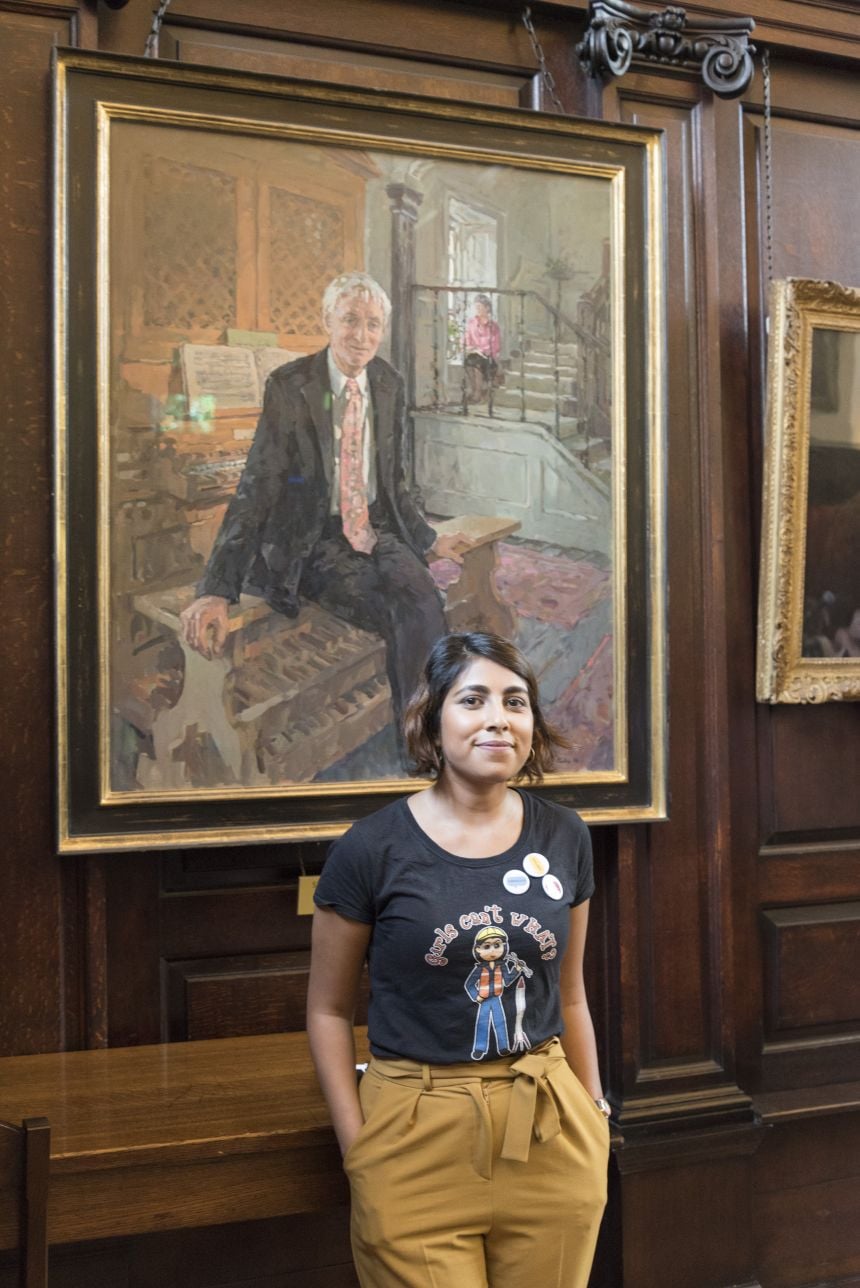 Dr Priyanka Dhopade was just named one of the UK's top 50 female engineers under 35, by the Women's Engineering Society.
Dr Priyanka Dhopade was just named one of the UK's top 50 female engineers under 35, by the Women's Engineering Society.In this spirit, Dr Dhopade, who was chosen by the Women’s Engineering Society, as one of 2017’s top 50 women in engineering under 35, recently organised a community outreach event to celebrate the International Women in Engineering Day (23rd June). During the event, young female science lovers, from across the county, (aged 13-15), had the opportunity to meet and learn from established industry leaders, over afternoon tea. Some attendees talk to Scienceblog about their experience of the day, and why female mentorship is so important to them.
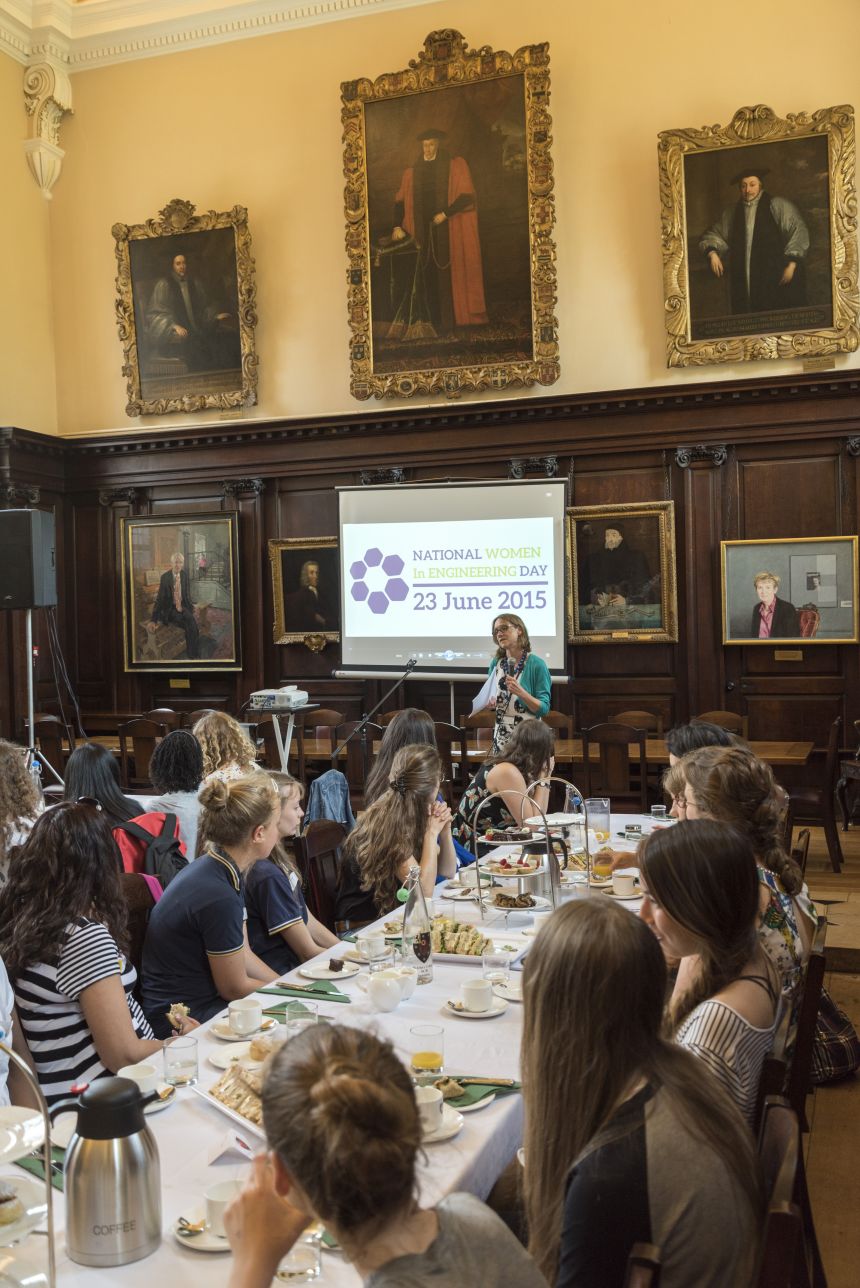 Professor Alison Noble gives a motivating speech at the National Women in Engineering Day Afternoon Tea.
Image credit: Janet Hovard
Professor Alison Noble gives a motivating speech at the National Women in Engineering Day Afternoon Tea.
Image credit: Janet HovardProfessor Alison Noble OBE FREng FRS, the event’s key note speaker, is a Professor of Biomedical Engineering and a co-founder of the medtech spin-out company; Intelligent Ultrasound Ltd. She discusses the vital role of engineers in society and her own personal journey towards being a successful engineer.
How would you describe your work to someone who knows nothing about engineering?
I am a senior academic engineer specialising in ultrasound image analysis, and I split my time between running a large biomedical engineering research group and raising funds for its activities. I also teach at the University, and I am Chief Technology Officer of my spin-out company, supporting the development of its products. I sit on a number of national committees that promote engineering in healthcare, and the commercialisation of science inventions and the growth of small science-based companies.
How has the industry changed during your career?
Image analysis deals with the extraction of meaningful information from ultrasound scans. When I started working in the field about 20 years ago, the academic and commercial focus was on imaging physics and improving image resolution, so that clinicians could see smaller structures and assess organ function. At that time, image analysis was considered a nice add-on, but not seen as having great commercial value. But, now the roles have in many ways reversed, or at least re-balanced. This is largely thanks to image digitisation, and more recently, the availability of large datasets, combined with advances in machine learning algorithms - particularly deep learning. Now, the focus is on how image analysis can be used to support workflow improvements and automatic diagnosis. My field has in a sense come of age, so there are exciting times ahead.
What research achievement are you most proud of?
At every career step there can be something special. For me, now, it has to be my recent election as a Fellow of the Royal Society. It is an incredible honour to receive such prestigious recognition.
What is the biggest challenge you face in your work?
Managing the many responsibilities, requests and expectations of an academic today.
What are your goals for the future?
My advanced European Research Council award is an ambitious project aiming to develop a next generation ultrasound imaging device, which is easier for a non-expert or occasional user to operate, than current systems. It uses machine learning to understand how an expert scans, and to build this knowledge into the ultrasound device. Realisation of this could have a big impact on use of ultrasound in healthcare.
We are also starting new collaborations in the developing world, specifically in Kenya and India. Unlike in the western world, women often do not go for antenatal check-ups during pregnancy. They only seek professional medical help if they feel very unwell. Working with overseas partners will help us to develop and evaluate imaging solutions that meet the unmet clinical need in these countries and could improve pregnancy risk assessment and outcomes in these challenging environments.
Are there any unique challenges to being a woman in engineering?
Two challenges come to mind, firstly, and perhaps surprisingly, as part of the movement to address gender im-balance in engineering, there are now arguably more opportunities presented to women to advance their career than men. But, this also means that women can be over-burdened with requests on their time, so individuals have to try to find a balance that works for them.
Secondly, the number of female directors, or members of senior management teams in companies - especially small ones, is depressingly low. I would like to see more women encouraged to get involved in innovation and set-up their own companies.
What more can be done to address the gender im-balance in engineering?
As with getting women into science, it all starts with school education. We need to teach school children to think creatively and to develop non-academic skills, which might inspire them to consider working in companies, and even setting up their own companies. Universities also need to take entrepreneurship education more seriously as core business.
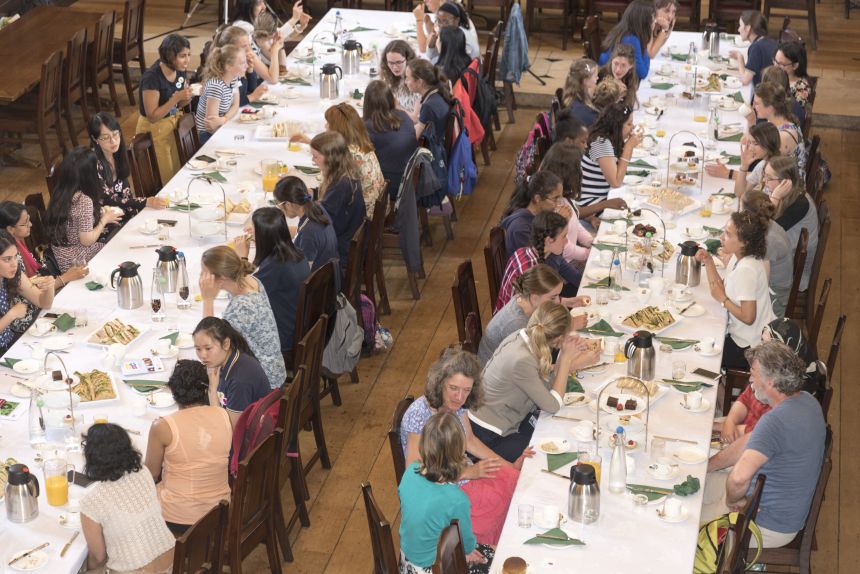 Image credit: Jane Hovard
Image credit: Jane Hovard Why do you think events like today’s International Women in Engineering outreach tea are so important?
Special interest meetings are really important and bring together people with a common interest. For some attendees, they provide an opportunity to network and share experiences. For others, attending a meeting of this kind can potentially change their life.
Gladys Ngetich, Rhodes Scholar, Aerospace Engineering Dphil Student, Department of Engineering, Oxford University
What is your research area?
My research involves developing advanced and more efficient cooling technologies for jet engines. We work in a close partnership with Rolls-Royce Plc and are trying to find a new method of cooling that will use as little air as possible. The principle being that, by improving the overall engine efficiency you reduce emissions.
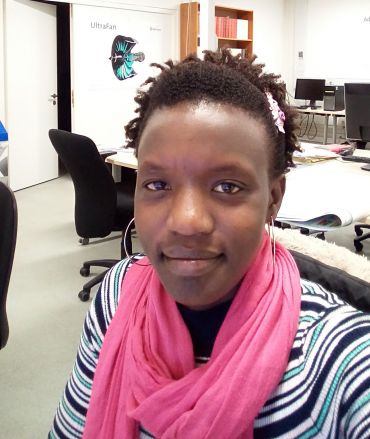 Gladys Ngetich, Rhodes Scholar, Aerospace Engineering Dphil Student, Department of Engineering, Oxford University
Gladys Ngetich, Rhodes Scholar, Aerospace Engineering Dphil Student, Department of Engineering, Oxford University
Did you always want to be an engineer?
Yes! My passion for engineering started when I was at secondary school in Kenya, where I grew up, but I always loved maths and science. My father and two of my brothers are engineers, so it was always a hot topic of conversation at our house.
What is the biggest challenge that you face in your field?
You need persistence and a lot of patience to be an engineer. Sometimes you have an idea that you think is great, but when you run the computer simulation to test it, it fails, so you have to start all over again. It can be a very long process that requires a lot of patience.
What are your goals long term?
I just want to be useful. Providing engineering solutions to all sorts of real world problems.
Are there any unique challenges to being a woman in science?
There is definitely a difference between being a man or a woman in engineering, and not just at Oxford. Even during my Undergraduate degree in Kenya, in a class of 80, I was one of eight women - that’s a ratio of one to ten.
Whether because of gender, or skin colour, when you are a minority it can be really lonely and challenging. You feel awkward, and it becomes about proving yourself. Proving to yourself and your classmates that you have as much right to be there as they do. At least half of the women in my class graduated with a distinction. It’s the same at Oxford, in a lab of about 30 DPhil students, I am one of three women, and one of two black students, so it’s a double challenge.
How can events like this support change in the industry?
I think there are lots of solutions, but for me, it is about encouraging young girls and talking to them from a young age about the importance of female role models and following your dreams. We have to really put the effort into supporting them to take STEM related subjects.
Some of the girls here today perhaps have never thought about a career in engineering, but after hearing Alison or some of the other speakers, they will start seeing it as a real possibility.
Never seeing someone that looks like you, working in the field that you dream of, can create a feeling that it’s not for you. Just being able to talk to, and even just see female and minority engineers makes all the difference.
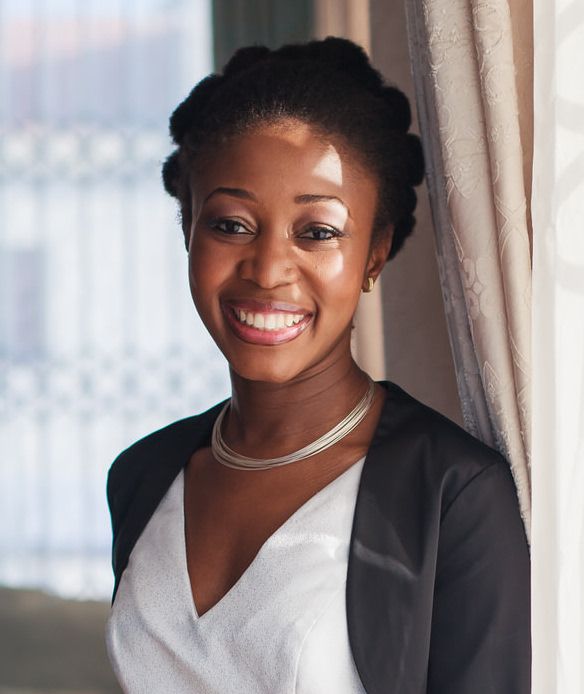 Dr. Ana Namburete, Royal Academy Engineering (RAEng) Research Fellow, Department of Engineering
Dr. Ana Namburete, Royal Academy Engineering (RAEng) Research Fellow, Department of Engineering Dr. Ana Namburete, Royal Academy Engineering (RAEng) Research Fellow, Department of Engineering
Did you always know you wanted to be an engineer?
I actually grew up thinking that I was going to be the first doctor in my family. I am from Mozambique, and my parents’ generation were the first to be able to choose their own career after Colonial Independence. My grandfather had always wanted to become a doctor, but not had that choice open to him. He spotted my passion for biology and helping people, and urged me to become a doctor.
I was focused on that goal at school, but during my gap year I volunteered at a clinic, where I realised that the lifestyle of a doctor did not actually suit me. There were new machines coming in all the time, but nobody spoke English well enough to translate the manuals. I speak fluent English and Portuguese, so I took on that role. While I was setting up the machines, I realised how much I liked the technical side of understanding how machines work. That was when I decided that I wanted to be an engineer.
I had already applied to university medical programmes. But, I was lucky, I was accepted into Simon Fraser University, a liberal arts university in Canada, where I could change my degree. I switched to the Biomedical Engineering course, and have never looked back.
What motivates you?
I recently won a Research Fellowship with the Royal Academy of Engineering to look at how we can automate fetal ultrasound images. Most of the structural development of the brain happens during pregnancy so there is big potential for impact. I created algorithms that can learn the normal pattern of prenatal brain development, detecting abnormal development in the process. Because ideally, if you can detect abnormalities early, you have the opportunity to intervene.
Ultrasound is portable and affordable, so useful for community services. If we automate the analysis, diagnosis and detection of brain structures, then community health workers can operate the machine and collect the images. Our algorithms do the hard work so they do not have to.
What do you like most about being an engineer?
I love being able to work with different people, understanding and translating their needs, into solutions. I also get to travel lots – Malawi, most recently. I visited clinics to assess their ultrasound needs and work out plausible interventions that we could provide for them.
Are there any unique challenges to being a woman in engineering?
Well, there are not very many of us, and that’s a problem. When I did my undergraduate degree, there were 20 women out of 400 students in the entire engineering department. A really bad ratio - and I was the only black woman in the program. I couldn’t help but feel different.
Inclusion is a real issue. But, that being said, I have rarely felt that doors are closed to me - particularly at Oxford, where I have always felt supported. My chances of winning my Fellowship were actually increased by having the support of the department, and Professor Noble my as my mentor and role model.
What needs to change to level the engineering playing field?
I think we need to see more role models, and for that, we need more women in the industry in general. Girls decide at a young age whether STEM is not for them, and we need to understand why that is.
The way we interact with technology in general today is completely different to when I was a teenager. Now everyone is a digital native, interacting with smart phoned and the web from a young age. This is good news for STEM.
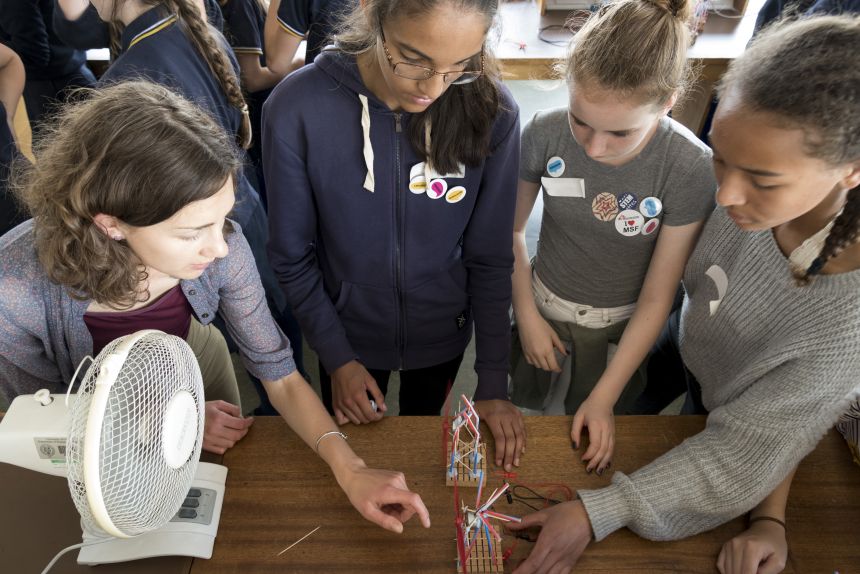 The girls' get hands-on, building a wind turbine.
The girls' get hands-on, building a wind turbine.
And what do the scientists of tomorrow think?
Mary Lee, 14 and Kitty Joyce, 15, Oxford High School, Oxford
‘We have really enjoyed this event and having the chance to decide what we want to do. We know that there are more men in science than there are women, but would never let this hold us back. Girls should be encouraged to do what they want, and women should have the same opportunities as men.
It has been great to meet new people, and take part in the practical workshop (led by Gabby Bouchard, Outreach Officer at the Department of Engineering). It was fun building the wind turbine.
‘We don’t learn about engineering at school and we should. We are here because we love science, but until today had never really thought about engineering as a job - but, that could change now.’
Sol Zee, 13 and Carys-Anne,14, Cherwell School, Oxford
‘It has been great to meet so many new people, and talk to other girls that love science too. We have a female science teacher, but listening to, and hearing how much the women here have achieved is really inspiring. It makes you excited that if you work hard, that could be you one day. We noticed that there are so many jobs in engineering that we did not know anything about, and will ask more questions about now.’
As Associate Professor of Organic Chemistry, a mother of two and one of Oxford University’s most successful entrepreneurs, developing both the spinout companies MuOx and OxStem, Professor Angela Russell wears many hats. She met with ScienceBlog to discuss the progress of women in science in the 21st century, her journey from academia to a successful business woman and her advice to anyone following in her footsteps.
What does your work in Organic Chemistry involve?
I run an academic research group aiming to develop new drugs to treat devastating degenerative diseases like Alzheimer’s and heart failure. The technologies we develop are helping us to answer fundamental clinical questions and understand how different substances affect regeneration processes in the human body. Our work is incredibly rewarding and has the potential to positively impact millions of peoples’ lives.
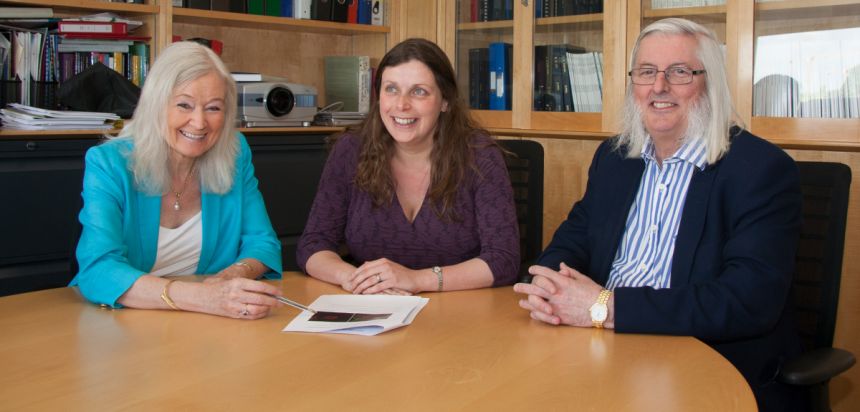 OxStem founders Professor Dame Kay Davies, Professor Angela Russell and Professor Steve Davies
OxStem founders Professor Dame Kay Davies, Professor Angela Russell and Professor Steve DaviesHas becoming an entrepreneur always been a goal for you?
I always thought I would be a pure academic scientist, so the business side of things was totally unexpected. Often when you make a scientific discovery the most exciting part of the project is seeing it applied, but it easy to become removed from the development process in academia, and, it got me thinking why not just do it myself?
How did your journey into science commercialisation evolve?
I have co-founded two successful Biotech companies and both evolved quite organically. Mentorship has been key. Professor Steve Davies in particular has been a huge influence on my career and a co-founder of both MuOx and OxStem. As an entrepreneur himself, he has always encouraged me down the road of the commercialisation of science.
How did you go about commercialising your research and developing a spinout company?
MuOx (Muscle Oxford) built on a longstanding collaboration with Professor Dame Kay Davies, looking for a new treatment for Duchenne Muscular Dystrophy. Our original findings had led to the formation of VASTOx (now Summit Therapeutics plc) who developed the drug ezutromid into clinical trials. We wanted to discover new drugs that could improve on ezutromid’s effectiveness and went back to designing new substances that took the original research to the next level; MuOx.
Often with spinout development selling your product can be a real challenge, but our ongoing relationship with Summit meant they bought us very quickly. The company was spun out in 2012 and bought for five million pounds, by Summit in 2013. We continue to run an extremely important collaborative research programme with Summit developing these new drugs for Duchenne Muscular Dystrophy.
The technologies we develop are helping us to understand how different substances affect regeneration processes in the human body. Our work is incredibly rewarding and has the potential to positively impact millions of peoples’ lives.
What was the biggest learning curve from the development?
Building a strong case for product development that can be easily communicated to anyone - scientists, investors and general public alike is not easy. But if you don’t get it right, you won’t get the investment. As scientists, we get used to talking to each other in scientific code, but it’s just jargon to anyone else. People can’t support or engage with something they don’t understand, so I had to learn quickly how to communicate to people with varying science knowledge, like patients and the general public. You have to build an exciting case and believe in it yourself: ‘not only is this exciting science, but we can deliver on it and change people’s lives.’ If you don’t believe in your product why should anyone else?
How did OxStem evolve?
MuOx proved that we could translate science effectively, and it gave me the confidence to go for it on a big scale with Oxstem, which was effectively MuOx 2.0. It is exactly the same premise, a company developing drugs to treat diseases. But where MuOx focused specifically on muscle degenerative disease, OxStem aims to develop a platform to treat any degenerative or age-related disease.
Was building the company very different the second time around?
Oxstem isn’t a single company, it is an umbrella company, and we spinout successful daughter subsidiaries, each with a different disease focus – four so far. As an academic research development, it has been hard and time consuming to communicate the value of this structure to university stakeholders. We had to outline the structural benefits and challenges, such as how the model could work within existing financial structures, management of intellectual property and so on. It took a long time, but we achieved our goal, and in May 2016 we hit our £17 million target needed to get the company off the ground.
 Professor Russell co-founded OxStem, the company is currently working to develop a regenerative treatment that could reverse the symptoms of Alzheimer's. Photo credit: OXSTEM
Professor Russell co-founded OxStem, the company is currently working to develop a regenerative treatment that could reverse the symptoms of Alzheimer's. Photo credit: OXSTEMProfessor Russell co-founded OxStem, the company is currently working to develop a regenerative treatment that could reverse the symptoms of Alzheimer's. Photo credit: OXSTEM
What was the biggest challenge you faced setting up a spinout?
Getting people to believe in your idea in the early stages is really difficult, particularly with funders. Investment is essential to progressing opportunities from lab experiments, to something that will be of benefit to patients in the long run. It takes a lot of time and patience and you have to be up front with people, making sure that they understand what they are getting into. Yes it is a lucrative investment opportunity, but there are risks.
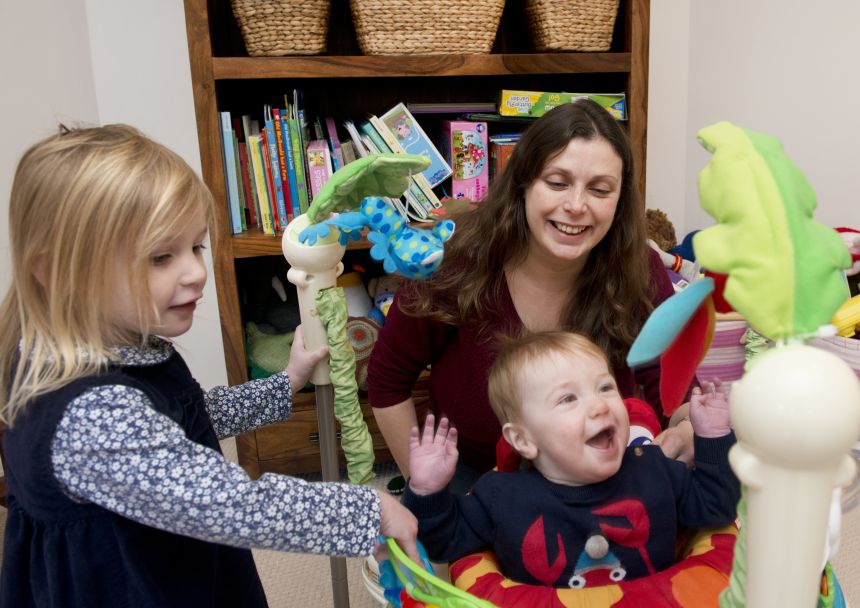 Professor Russell playing with her two children
Professor Russell playing with her two childrenWhat advice would you give to someone looking to commercialise their research?
Identify a clear market need for your product, make a clear development plan and a list of reasons why you are the only one that can deliver on it. That is the way to be successful. Being actively involved in progressing your research is so rewarding. If you truly believe in your idea, this is the route for you.
Generally getting government or charity funding for discovery science is straight forward, but doing so for an idea that you want to translate into a research led, spin-out is not so easy; dubbed the “valley of death”. You have to have proof of concept, and show that your idea is going to work.
What projects are you currently working on?
The bulk of my work focuses on the development of new drugs to tackle degenerative and age-related diseases. For instance in collaboration with Professor Francis Szele we are looking at treating diseases like Alzheimer’s and other neurodegenerative conditions and how symptoms can be reversed. A disease like Alzheimer’s is characterised by the progressive loss of neurones in the brain, and we are working to develop a regenerative treatment that will replenish these neurones, reversing the symptoms of the condition in the process. It will make a tremendous difference to people’s lives. If all goes to plan, we will be ready to run a clinical trial in the next three to five years.
You have to build an exciting case for your product, and believe in it yourself. If you don’t believe in it why should anyone else?
Has being a woman in science posed any specific challenges for you?
I have never been discouraged or made to feel that I can’t achieve things because I am a woman. Nor have I ever felt it was an advantage either. I think that is really important. We can’t solve gender bias against women, by deflecting it to men. We have to create an environment where it is better for everybody. I am heavily involved in the Athena SWAN Charter, self-assessment process, and it’s not about creating more opportunities for women, but for everybody, and achieving equality across the board.
How do you think these opportunities can be created?
I think we have to change the working culture, and focus more on valuing people for what they contribute, not how long a day they work. In the past there was a more blinkered view that a brutally long working day was the only way to succeed, which made managing a family and a career almost impossible, but that is changing.
We can’t solve gender bias by deflecting it to men. We have to build an environment that is better for everybody. Not just creating more opportunities for women, but achieving equality across the board.
What motivated you to become a scientist?
My dad was always supportive of my ambitions. When I was 14 he told me ‘you’ll never be happy with a desk job.’ He was right. I’ve always been driven by a desire to carry out research for the betterment of human health. Chemistry was a subject I absolutely loved at school and saw as fundamental to all science because it underpins and impacts so many other disciplines, including medicine.
What advice would you give to someone embarking on a career in STEM?
The decisions that you make at the beginning of your career are important, and can impact your whole future, so try and think long term wherever possible. Everyone makes mistakes, but recognising when you aren’t on the right track and correcting it quickly makes it easier to stay on course. I came to Oxford to study Biochemistry, but realised quickly that it wasn’t for me. Two weeks before my first year exams I told my tutor I wanted to change to Chemistry. I flipped straight into the second year of a Chemistry degree, and almost gave my tutor a heart attack, but it was exactly the right decision for me.
If you hadn’t been a scientist what was your plan B?
I would have been a chef. I actually think chemists and chefs have a lot in common. They experiment with flavour combinations and we scientists cook up drugs that we want to use for clinical use. There is nothing more rewarding than cooking a nice dinner and watching your children tuck in.
 In her spare time Professor Russell enjoys cooking for her family, and has found parallels between chemistry and cooking. Chefs experiment with flavour combinations, while scientists cook up drugs for clinical use. Image credit: SHUTTERSTOCK
In her spare time Professor Russell enjoys cooking for her family, and has found parallels between chemistry and cooking. Chefs experiment with flavour combinations, while scientists cook up drugs for clinical use. Image credit: SHUTTERSTOCK
In her spare time Professor Russell enjoys cooking for her family, and has found parallels between chemistry and cooking. Chefs experiment with flavour combinations, while scientists cook up drugs for clinical use. Image credit: SHUTTERSTOCK
In a guest blog, Professor Peter McCulloch from the Nuffield Department of Surgical Sciences, explains the importance of randomised trials in deciding whether subsequent trials are necessary.
In medical science, as in all walks of life, we are impressed by dramatic effects. If a new treatment seems much better than an old one initially, there is often impatience to get on and use it, and people question why one would want to conduct formal trials.
Doctors who feel this enthusiasm for what they see as a breakthrough often argue that it’s not ethical to do a randomised trial of an exciting new treatment, because the benefits seem so obvious, and randomisation means that half the patients are deprived of them. Of course breakthroughs sometimes turn out to be false dawns, but the idea that something might be so obviously better than what we have now that it doesn’t need a randomised trial is pretty widespread in medicine.
We decided to look at this by trying to find all the published randomised trials where the new treatment was reported as being five times better than the previous treatment (or a controlled group). We thought this ‘five times better’ idea might be a useful rule for medical science. If a hazard ratio of five (i.e. the new treatment is five times better) nearly always predicted correctly that subsequent trials would always report significant benefits, then we could use this as a signpost for the point where no further evidence is needed. Unfortunately, this turned out not to be true.
We studied all of the trials in the Cochrane Collaboration Database (more than 80,000) and found that there were very few instances where there had been both trial with a dramatic effect like this and a subsequent trial. We looked at the ones we found and unfortunately the ‘five times better’ rule was wrong in over one third of the cases. In other words, even though an earlier trial showed the new treatment as five times better, a subsequent trial said it was not significantly better at all. We tried to find a rule which worked by increasing the hazard ratio or the significance of the results. We found that we had to increase the hazard ratio to 20 (i.e. the new treatment is 20 times better than the old treatment) before the rule became 100% reliable. Out of the whole Cochrane database there were only four trials that fitted this rule.
So why doesn’t this rule work? The main problem is an effect known as ‘regression to the mean’. Most of the trials that show dramatic effects are small trials, and we know that a small trial has a better chance of producing a freak result than a large trial through the effects of pure chance. Smaller randomised trials also tend to be of lower quality than larger ones and therefore open to greater degrees of bias. The implications, particularly for surgery, are quite interesting. It’s well known that it’s much harder to perform a large randomised trial in surgery than it is when studying a drug. However, our work adds to the literature showing that small randomised trials are pretty unreliable. Given that they are also very expensive and difficult to do, our results throw into question whether surgeons might be better to do another type of study in situations where they know that they won’t be able to do a large enough randomised trial to avoid the effects we are talking about. There will always be exceptions to this rule, particularly for rare diseases, but our findings could be used to support the idea that in surgery it may be useful sometimes to do a large non-randomised prospective study before committing to the major undertaking of developing a large high quality randomised trial.
The full paper ‘Very large treatment effects in randomised trials as an empirical marker to indicate whether subsequent trials are necessary: meta-epidemiological assessment’ can be read in the BMJ.
- ‹ previous
- 4 of 8
- next ›

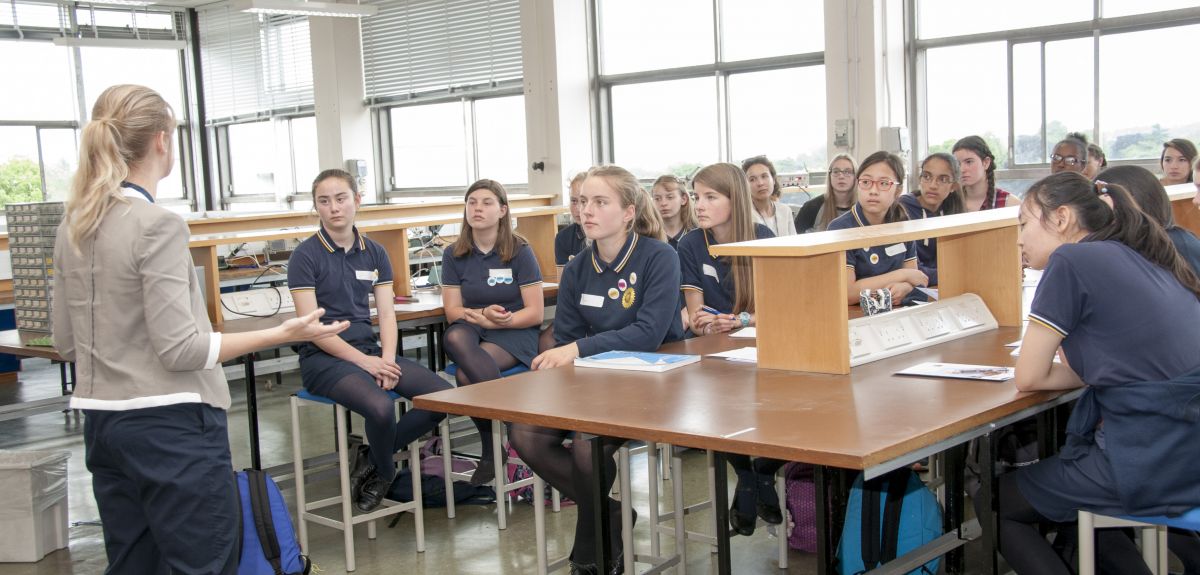


 World Malaria Day 2024: an interview with Professor Philippe Guerin
World Malaria Day 2024: an interview with Professor Philippe Guerin From health policies to clinical practice, research on mental and brain health influences many areas of public life
From health policies to clinical practice, research on mental and brain health influences many areas of public life From research to action: How the Young Lives project is helping to protect girls from child marriage
From research to action: How the Young Lives project is helping to protect girls from child marriage  Can we truly align AI with human values? - Q&A with Brian Christian
Can we truly align AI with human values? - Q&A with Brian Christian  Entering the quantum era
Entering the quantum era Can AI be a force for inclusion?
Can AI be a force for inclusion? AI, automation in the home and its impact on women
AI, automation in the home and its impact on women Inside an Oxford tutorial at the Museum of Natural History
Inside an Oxford tutorial at the Museum of Natural History  Oxford spinout Brainomix is revolutionising stroke care through AI
Oxford spinout Brainomix is revolutionising stroke care through AI Oxford’s first Astrophoria Foundation Year students share their experiences
Oxford’s first Astrophoria Foundation Year students share their experiences